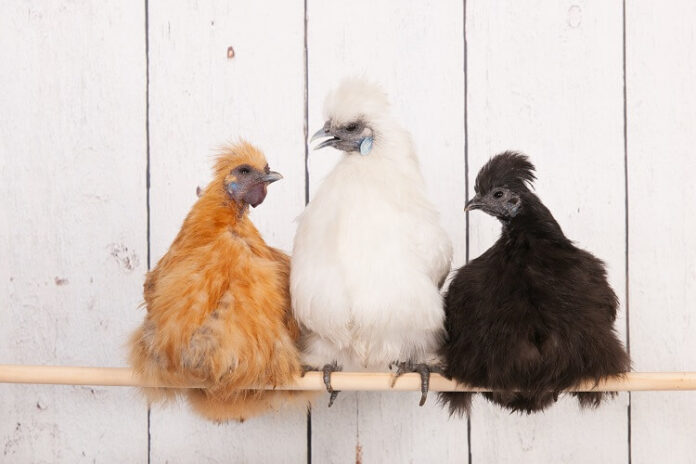Last Updated on July 2, 2021 by Fumipets
The Silkie chicken is a special breed of chicken commonly referred to as fluff-balls, aliens from another world, teddy bears, and a host of other aliases.
Undoubtedly, they are indeed unusual-looking chickens!
Their odd-appearance, friendliness, and maternal skills are perhaps the most prominent of what endears them to many people.
In putting the spotlight on Silkie Chicken it is important to consider, among other qualities, their history, temperament, egg-laying capabilities and the environmental conditions that best suit them.
Overview
| Silkie Chicken | |
| Lifespan: | 7-8 years. |
| Weight: | Hen (1.5-2lb) and Rooster (2-3lb). |
| Colour: | black, grey, white, blue, buff, splash, and partridge. |
| Egg Production: | 2-3 per week. |
| Egg Color: | Cream to tinted. |
| Known For Broodiness: | Yes. |
| Good With Children: | Yes. |
| Cost of Chicken: | $5-$120 depending on color and quality. |
| Beginner Friendly: | Yes |

Background
It is widely believed that Silkie chicken is an ancient breed of Chinese ancestry dating back to as far as the Chinese Han Dynasty, in 206BC.
Alternately called the Chinese Silk Chicken, evidence suggests a quite strong Chinese origin, but it cannot be substantiated completely.
The first reference to Silkie Chicken was made by Marco Polo (around 1290-1300) on his grand voyage across Europe and the Far East. Though he did not see the bird, it was reported to him by a fellow traveler, and he reported it in his journal as “a furry chicken.”
The Silkie chicken found its way to the west either by the Silk Road or by the maritime routes, likely both.
The ancient Silk Road spans from China to modern-day Iraq with several secondary routes crossed over into Europe and the Balkan states.
Italian born Aldrovandi made the second reference in 1598, when he spoke of a chicken with “fur like a black cat.”
The introduction of Silkie Chicken to the European public around the 1800s was met with initial skepticism. It was astonishingly rumoured to be an offspring of an unholy union between a rabbit and a chicken.
A number of the first owners of this rare specie of chicken obtained them out of curiosity and inquisitiveness as it was usually displayed in ‘freak shows’ as a ‘bird-mammal’.
However, scientific evidence have proven that these breed of chicken, although unique in it’s nature, is pure and has no mammalian ties.

Appearance
As pointed out earlier, Silkies are oddly different in numerous ways from a ‘regular’ chicken, especially in terms of appearance.
The head is artistically crested and bears some sort of semblance similar to a polish chicken. If a comb is present, it is almost circular in appearance – like a ‘walnut.’
In most cases, the comb coloring is black or dark mulberry – any other colour, and it is not a pure Silkie chicken.
They posses a unique oval-shaped turquoise, complemented with blue earlobes and dark-colored wattles.
Their short beak is quite broad at the base, and is usually grey or blue in colour. It is important to add that their eyes are black.
Their bodies are usually broad and stout, the back is short, and the breast is full.
Silkie Chickens posses five toes as against the usual four found in chickens. The outer two toes are usually feathered.
Their grey-coloured legs are short and wide-set.
The feathers of Silkie Chickens do not contain barbicels (the hooks that hold feathers together), hence the fluffy appearance.
The main feathering looks just like the under-down of regular chickens. This, however, does not entirely impede their flight, as the chickens could still fly under certain circumstances.
On the flip side, the loose feathering also means that the chicken is not waterproofed, and so a wet Silkie chicken is a pitiable sight to see.
If they do get wet to a large extent, they need to be properly towel-dried or even blow-dried – which they enjoy if it is done regularly.
Underneath all that fluff, the Silkie has black skin and bones.
The meat is also used in Chinese medicine due to its high carnitine concentration as compared to other chicken meat – carnitine is assumed to contain anti-aging properties, although this claim is disputed.

Breed Standard
The Silkie chicken was accepted into the British Poultry Standard of Perfection and the American Poultry Association standard in 1865 and 1874 respectively.
Similarly, the Australian Poultry Standard accepted the bantams sub-breed of Silkies in 1998.
Although all Silkies in the US and Canada are considered to be bantam irrespective of their size. Every other country in the world recognizes both bantam and large fowl sub-breeds.
In the United Kingdom large fowl Silkies weigh as much as 2 kg for the male and around 1.5kg for females. Bantams, on the other hand should weigh a paltry 600g for males and 500g for females.
Accepted colours include black, grey, white, blue, buff, splash, and partridge. Other colours like lavender, cuckoo and red are available but they are not yet accepted in the American Poultry Association (APA).
Taking Care of Silkie Chickens
Although, the Silkie chicken is fairly a low maintenance breed, there are certain conditions that must be met to bring out the best in them.
Silkies tolerate confinement well provided they have enough room and perches to play around.
Also, it is important to pay attention to their special needs as a result of their lack of the barbicels on their feathers.
Because their feathers do not protect them against bad weather. Silkies are likely to get soaked to the skin in wet weather. So they need to have access to a secure dry place out of the weather.
If they do get wet they will need to be dried off and kept warm until they attain their normal temperature.
In addition, some strains of the Silkie are more prone to Marek’s disease than others. Although you can get your birds vaccinated at source, if you are buying from a private breeder it is worth your time asking about this disease.
Regular health checks for parasites should be routinely carried out. It can be treated as needed or scheduled regular treatments.
The lifespan of Silkies is usually between 7 and 8 years, but with lots of loving and care, they can live much longer.
Feeding Silkies is relatively cheap as they eat only about 100g of feed per day. They can be fed with standard 16% layer feed.
Augmenting their feed with fresh greens and the occasional treat will keep them happy, active and healthy.
To set up a perfect coop for Silkie Chickens a minimum of 4 square feet per bird is required.
They are partly weird; in that they really do not care to roost at night. They much prefer to pile up together on the floor to sleep. To ensure that rodents and insects do not disturb them at night, building a raised platform a few inches off the floor for them to sleep on is necessary.
For nesting boxes, it is imperative to bear in mind that Silkies cannot fly, therefore, their nesting boxes need to be easily accessible. Placing the nests on the ground is a smart option, as is raising them a few inches and having a small platform for them climb to access the box.
While Silkies love free ranging outside the coop, they are an easy target for predators since they barely fly.
A good arrangement would be to have an outside area cordoned off and protected. You would also need to provide some overhead protection from hawks or owls.
Standard sized birds will each require a minimum of 8 square feet in the run (bantams slightly less). If you have space to provide more room, do! More is better.

Egg Laying
Silkies are not really a great breed for egg production. For most strains, a 120 egg per year output is a really great deal (this equates to about 3 eggs per week as against 6 eggs produced by regular chickens).
Their eggs are cream to tinted in colour and are small to medium in size.
They begin laying earlier in the year than most hens, starting up once the days begin to get longer – occasionally late December but more often early January.
Temperament
In terms of temperament, silkies are known to be calm, friendly, and docile.
However, this docility can lead to them being picked on by other more ‘pushy’ flock members.
Expectedly they are at their when put with others of a similar nature, like the Polish hen.
Despite their fluffy feathering, they tolerate the cold fairly well – with the exception of wetness though
Silkies are more renowned as being pets, brooders, and ‘ornamental’ birds.
Determining the sex of a Silkie chicken is notoriously difficult until around six months old.
Health Issues
We earlier pointed out that a silkie chicken can be quite susceptible to Marek’s disease.
Marek’s disease is a viral disease of chickens that is caused by a herpes virus.
While silkie chicken can be bred for natural immunity, vaccination has proven to be of immense benefit over time.
With Silkies being very fluffy, they can be a target for mites and lice, so they require special care and due diligence.
Occasionally, one may also need to trim the feathers around their eyes to help them see a little better.
Occasionally, the fluff at the rear end does need trimming for hygiene and breeding purposes.
Advantages of Rearing a Silkie Chicken
In addition to being friendly with kids, Silkies generally make good pets as a result of their clinginess. Also they live for a relatively long time and get along well with other chickens. Another worthy mention is the fact that they are presumed to be great mothers.
Disadvantages of Rearing a Silkie Chicken
Expectedly, Silkies have a number of cons, including but not limited to their susceptibility to Marek’s disease. They are also difficult to cater for in cold weathers. Also their egg-production quota is significantly low and they are often victims of lice/mite infestations. Futhermore, they are known for being broody.
What to do if a Silkie Gets Wet
In cases of wetness, drying your Silkie chicken quickly can be the difference between life and death for your fluffy chicken.
Since the feathers do not stick together on this “furry” breed, they aren’t insulated, like other breeds of chickens. This means they can catch a chill easily and die of hypothermia, especially if they live in cold climates.
Commonly Asked Questions About Silkie Chickens
Do Silkie Chickens Lay Eggs to Eat?
Yes, a silkie chicken is considered a backyard chicken, and they lay white/cream-colored eggs that are safe to eat.
How Often Do Silkies Lay Eggs?
A silkie chicken can lay about 120 eggs per year, about 2-4 eggs per week.
Are Silkie Chickens Expensive?
The price of a silkie can vary. Top-quality silkie chicks can cost around $10-$15, and hens can cost between $20-$50.
What colours do Silkie chickens they come in?
There are eight recognized colors: black, blue, buff, gray, partridge, self-blue, splash and white.
Conclusion
As a pet the Silkie chicken always brings a smile to peoples’ faces. This ‘odd-ball and slightly unusual bird is certainly a sight to behold!
While they won’t give you many eggs, they will complement that by supplying you will a lot of love, smiles, and cuddles. When they become bonded to their owners, they can be described as ‘dog-like in their devotion.
They are certainly a great bird to have around if you have eggs you want to hatch but don’t want to fiddle around with an incubator.
All in all, these funny little birds are a joy to have and give much pleasure to their owners.



















